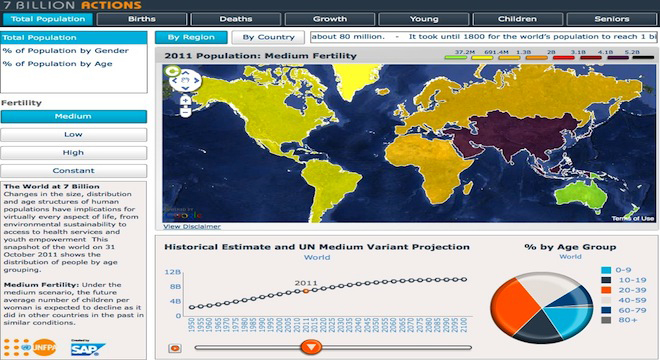Even though it’s impossible to know when the world’s population is really going to hit the 7 billion mark, the United Nations has designated Monday as the official day when it’s going to “celebrate” the milestone.
The goal is to raise awareness of the challenges the world faces as our population grows.
“Changes in the size, distribution and age structures of human populations have implications for virtually every aspect of life, from environmental sustainability to access to health services and youth empowerment,” the UN notes on its web site 7billionactions.org, which uses media of various kinds to help us to conceptualize what having 7 billion people on the planet really means.
The UN wants policymakers to think ahead and plan for all these people. The body collects oceans of demographic and population trends from all over the world, and it’s now sharing some of that information on its web site through two widgets it is calling its “Population Dashboards.”
The dashboards, created by the software and consulting firm SAP, allow site visitors to explore the UN’s data visually on a global map with a few clicks of the mouse, by region, and by country.
There are loads of interesting factoids in the UN’s data: For example, two thirds of the world’s population is currently under 40 years old.
As the narrator of one of the videos below notes: “The world now supports the biggest generation of young people in history, and a growing number of old people.”
Afghanistan and Pakistan are at the forefront of this trend: 32 percent of the country is under the age of 9; 83 percent is under 40 years old. In Pakistan, almost half of its population is under the age of 19.
The UN’s dashboards also illustrate just how hard it is to plan for the future however. As the narrator in the video below says, “small changes in assumptions make a huge difference on the ground.”
One of the biggest factors is fluctuations in fertility rates, for example. Depending on what fertility rates are assumed, we could end up with either 6.2 or 16 billion more people by the end of the century.
Nevertheless, the people at the UN obviously believe that this unpredictability is even more reason to constantly monitor how we are growing and how we can make that growth sustainable. And that makes sense, since, as many an archeologist can tell you, unsustainable growth has historically led to past civilizations’ inevitable decline.






